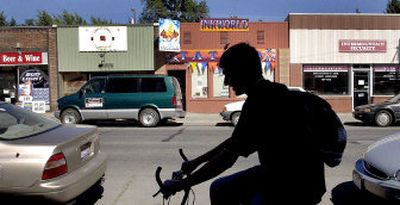Midtown weighs strengthened identity

Midtown merchants wrestled over the future of their Coeur d’Alene shopping district Tuesday night, attracted to pictures of pocket parks, quaint store facades and park benches in other communities, but wary of what change could bring.
Most liked the idea of beautification. Others fretted over higher taxes and changes in traffic patterns.
“We’re going to talk about what midtown could be, should be, and shouldn’t be,” Mark Hinshaw, an urban planner from Seattle, told the crowd at the beginning of a two-hour workshop. “I don’t think you would want this to become a generic place. … You want it to stay true to itself.”
The workshop was organized by the Lake City Development Corp., which is Coeur d’Alene’s urban renewal agency. The goal was to brainstorm ways to make midtown a destination.
Midtown stretches north from downtown Coeur d’Alene to Interstate 90. Retail shops thrived in the area before the advent of malls and big box stores. Now the district is a jumble of vacant lots, pawn shops, Laundromats and thrift shops. Sprinkled in are longtime Coeur d’Alene establishments, such as Yates Funeral Home.
Midtown’s cachet is already on the rise.
“We’re seeing the energy from downtown starting to dribble up to midtown,” said Tony Berns, LCDC’s executive director. “Rents are cheaper and people see it as an up-and-coming place.”
Given its proximity to downtown, midtown would probably revitalize on its own, Hinshaw said. But several things would speed up the process, he added.
Appealing streetscapes – with charming facades, public art, trees and benches –would slow traffic and attract shoppers. Building apartments above shops would create a customers base, Hinshaw said. Creating a distinct identity for midtown is also important, he said, because people like unique places.
“They hang out there, they shop there, they visit there,” Hinshaw said. “They bring their family and friends there.”
Midtown was like that during Ione Raugust’s youth. “It was a busy place during the ‘50s and ‘60s,” she said. “There were several bars, a doughnut shop, two grocery stores, and a dime store.”
Raugust manages the Idaho Youth Ranch on Fourth Street. She’d like to see the vitality return to midtown, and the area spruced up with “brick streets and trees and benches.”
Discussion of traffic patterns was more controversial. Hinshaw is one of several urban planners who has suggested a return to two-way traffic on Third and Fourth streets. LCDC will partner with the city of Coeur d’Alene at some point to study the issue, according to Berns.
“Virtually everyone who has looked at how you could make it a stronger retail area has said the same thing,” Hinshaw said. “With one-way traffic, the intent is to move people through. Ninety percent of the people who go through have no interest in stopping.”
Tom Capone and his wife, Teresa, operate Capone’s Pub & Grill on Fourth Street. The pub is one of midtown’s success stories, with four expansions over the last 14 years.
“We’re a destination spot, so the traffic doesn’t really matter,” Tom Capone said.
Others wondered if a revamped midtown would lead to higher property values, and ultimately higher taxes. A homeowner on Third Street said he liked living in a quiet area, and doesn’t support denser development.
Berns urged people to contact him if they want to be part of future discussions. Views from midtown residents will shape LCDC’s involvement there, he said.
“We’re not going to shove anything down their throats.”